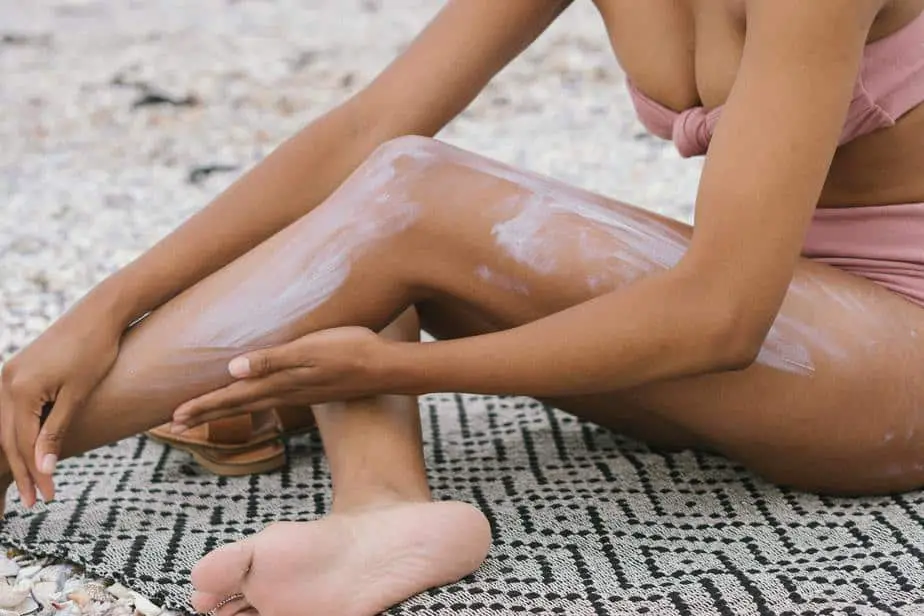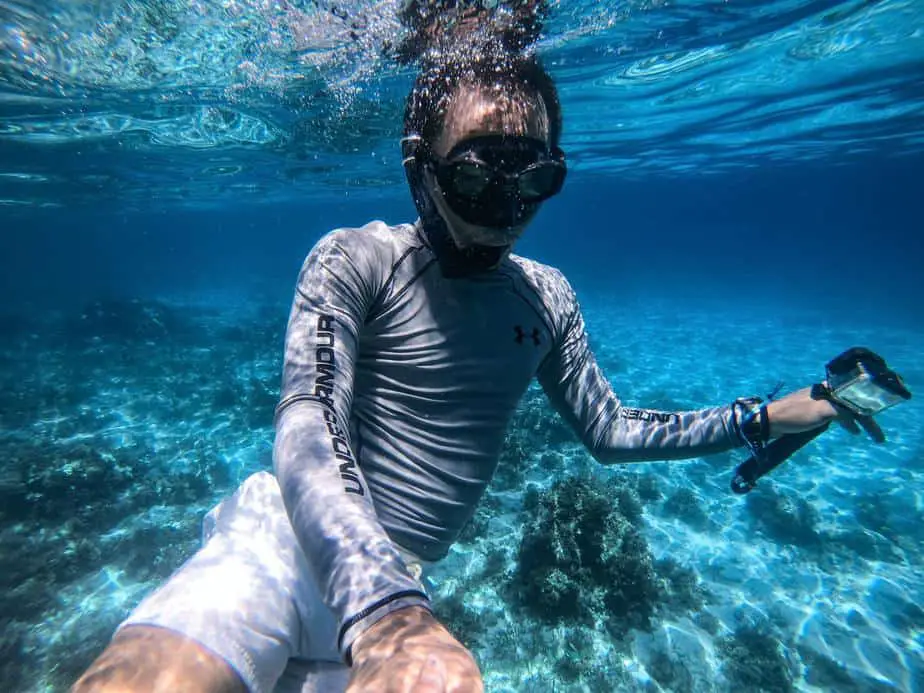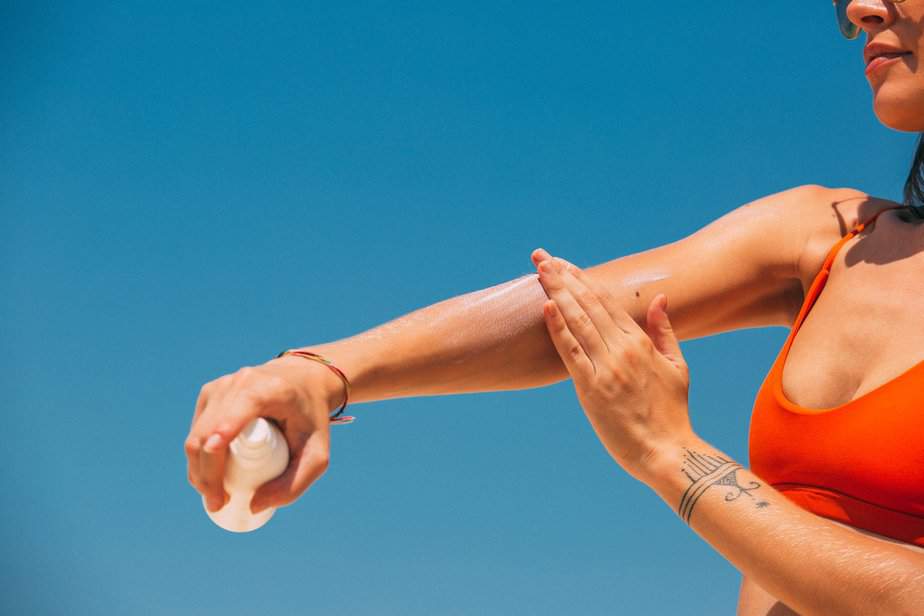As nice as it feels to go swimming on a hot summer day, unfortunately swimming outdoors comes with some risks. The most prominent risk is not sharp corals, sharks, strong currents, or other people (though you should still be careful around them), but rather the sun. If you are swimming outdoors, you will be exposed to the sun, and its harmful UV rays will affect you.
The sunlight provides a comforting warmth on our skin in moderation, but too much can lead to unwanted tanning, sunburn, rapid aging of the skin, and even skin cancer. If you plan on swimming outdoors for any length of time, you had better be prepared to protect your skin from the sun’s UV rays.
You can get tanned even if you are underwater. The best ways to protect your skin from the sun while swimming are to wear a broad spectrum water resistant sunscreen, UPF rated clothing such as full body rash guards, and to constantly reapply the sunscreen every 30-60 minutes depending on the sunscreen. Any areas not protected by sunscreen or UPF swimwear will get tanned (or worse).
If you just want to go swimming without worrying about getting a tan, then your best option is to simply swim indoors. Then you can just wear a regular bathing suit and not have to worry about (re)applying sunscreen when you just want to spend time in the pool.
Why you should be wary of the sun

Have you ever seen photos of people who didn’t apply sunscreen evenly? Maybe they were a bit lackadaisical in their application, or maybe there were areas that they simply couldn’t reach (or simply forgot about). However, the end result is that any patch of skin that wasn’t protected by sunscreen was bright red and also tanned.
What’s happening is that the sun produces ultraviolet radiation (UV rays), and prolonged exposure to UV rays can damage the DNA of skin cells. There are two types of UV rays: UVA and UVB rays.
UVA rays can cause tanning and sunburn. It is the most common UV ray, comprising 95% of the UV rays that reach the Earth’s surface. It can penetrate glass and even cloud cover, so it shouldn’t be surprising that it can also penetrate deep into our skin.
Since not even clouds can fully block UVA rays, swimming outdoors will expose you to an abundance of UVA rays even on a nice and cool cloudy day. Essentially, if you go outdoors at all and aren’t protecting your skin, expect to get a tan eventually.
Some people tan on purpose because they want to get attractive bikini tan lines. Obviously, if you’re reading this article about how not to get tanned while swimming, you don’t fall into this category. That wasn’t an insult, by the way; you are very much justified in not wanting to get tanned.
There is no such thing as a “healthy” tan. A tan is just the skin darkening to prevent further damage from occurring due to the UVA rays. And boy, UVA rays do serious damage. In addition to giving you a tan, they also cause your skin to age rapidly, giving you the appearance of someone years older than your actual age, and can also cause skin cancer on top of all of that.
The importance of wearing sunscreen

For a time, sunscreens only protected people from UVB rays. UVA rays were once thought to be safe, but now we know they are extremely harmful as well.
UVB rays have similar effects to UVA rays. However, they can be filtered, they do not penetrate glass, and their intensity fluctuates depending on the time of day (around 10 am – 4 pm), whereas UVA rays retain the same level of strength during daylight hours. Note that during these peak hours, the intensity of UVB rays exceeds that of UVA rays.
So while UVB rays can technically pose similar risks as UVA rays while swimming, due to the fact that it can be filtered, it’s not nearly as prevalent as UVA rays (accounting for only 5% of total UV radiation on Earth). That said, if you happen to be swimming outdoors during the hours of 10 am – 4 pm, you are going to be receiving the full brunt of both UV rays.
Now that we know both UV rays are dangerous, broad spectrum sunscreen, which protects our skin from both, was introduced. When buying sunscreen, look specifically for ones that offer “broad-spectrum protection”, otherwise you are only getting protection from UVB rays.
As mentioned, tanning is actually the least of your concerns when swimming outdoors. The real danger is the potential for developing skin cancer. When UV rays damage your skin cells, melanoma, a type of skin cancer, can form. This is the skin cancer that causes the majority of skin cancer related deaths.
Wearing sunscreen will protect you from suntan, sunburn, skin cancer, rapid aging, and any other detrimental effects that UV rays can cause. Don’t leave home without applying it.
Wear UV-protective clothing

If you’re not a fan of slathering sunscreen on every square inch on your body, then UPF swimwear will be a godsend for you. All swimwear should have a UPF rating, which means that they offer protection from UV rays.
Remember how we said that UVA rays can penetrate even through glass and cloud cover, reaching deep into your skin? It can also penetrate clothes without a UPF rating. If you thought covering up by wearing a T-shirt was a smart solution, you’ll have to think again.
People who really hate applying sunscreen should just get a full body rash guard. By covering the majority of your body, you only need to apply sunscreen on the remaining exposed areas.
What makes UV-protective clothing such a good solution is the convenience and cost savings it provides. Applying sunscreen to your entire body will make you go through tubes of the stuff in no time, which is costly.
Plus, sunscreen washes off, so you need to constantly reapply it every 30-60 minutes or however long the label says. This is extremely annoying to do and also uses up your sunscreen quickly. You are also likely to forget to reapply sunscreen from time to time.
With UPF swimwear, since most of your body is covered up, you do not need to reapply sunscreen to the covered up areas. Even if you do forget to reapply sunscreen, if you’re wearing UV-protective clothing, the majority of your skin is still covered regardless.
Lastly, you still need to apply sunscreen to your exposed skin when wearing UPF clothing. It is not an either/or, you should do both!
How to prevent tanning while swimming
With all of this information in mind, here is how you can put it to good use:
- Swim early during the day or late in the evening. The UV rays are at their full intensity during the hours of 10 am and 4 pm. Go swimming sometime before or after those hours.
- Apply sunscreen 30 minutes before going outside. It takes some time for the sunscreen to get absorbed into your skin to provide protection. If you go out too quickly, it may not offer as much protection. Plus, you might accidentally rub off the sunscreen if your skin comes into contact with anything. Note that you can still get tanned while wearing sunscreen; it will just happen much more slowly.
- Wear UV-protective swimwear. The more coverage, the better. You do not need to apply sunscreen to areas covered by UPF swimwear, nor do you have to reapply sunscreen to those areas, greatly reducing how much sunscreen is required.
- Remember to reapply sunscreen. The frequency with which you must reapply sunscreen differs depending on the type of sunscreen. Water resistant sunscreen can last for 30-40 minutes, whereas waterproof sunscreen can last up to 80 minutes. Remember to only reapply sunscreen after toweling off, as any wiping can remove the sunscreen before it is absorbed by your skin.
- Wear a swim cap. Especially if you have colored hair or sensitive hair that might get damaged by the UV rays. In addition to the sun protection, a swim cap can also limit your hair’s contact with saltwater.
Does all of this sound like a pain in the butt? Well, you could always choose to swim indoors. Then you don’t have to worry about stuff like sunscreen or a rash guard; you can just swim to your heart’s content without worrying about tanning.
That said, you do still have to worry about getting all of that chlorine out to prevent damage to your hair and bathing suit, so maybe it takes an equal amount of work regardless.


